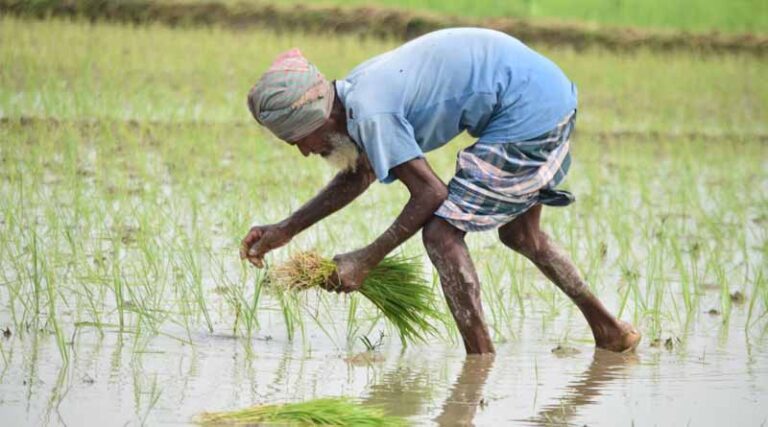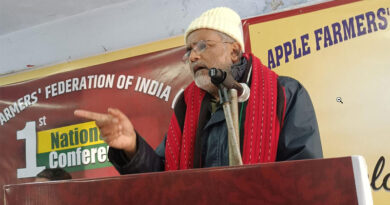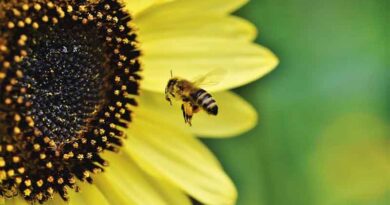
Reply to Calling Attention Motion regarding ‘Southern Rice Black-Streaked Dwarf Virus
27 August 2025, Chandigarh: Haryana Agriculture and Farmers’ Welfare Minister Mr. Shyam Singh Rana said the State Government is alert regarding ‘Southern Rice Black-Streaked Dwarf Virus’ (SRBSDV). Agricultural scientists are monitoring the situation, and farmers are being made aware.
He informed that in organic farming and in direct seeding of rice, there has been no report of damage due to this virus. If farmers sow paddy according to the State Government’s agriculture policy and the advice of agricultural scientists, then such diseases can be largely prevented.
The Agriculture Minister was replying to a Calling Attention Motion brought by some members in the House during the ongoing Assembly Session.
Mr. Shyam Singh Rana informed that ‘Southern Rice Black-Streaked Dwarf Virus’ (SRBSDV) is a viral disease that affects the paddy crop and has become a matter of concern in many rice-producing areas of India. This disease spreads through a vector called White-Backed Plant Hopper (WBPH), which sucks the sap of paddy plants and transmits the virus from infected plants to healthy ones.
He said that due to this virus, the normal growth of infected rice plants stops, making them stunted with much less height than normal. Their leaves turn dark green, the development of new buds slows down or stops completely, and the roots turn brown and remain underdeveloped, reducing the plant’s ability to absorb water and nutrients.
The Agriculture Minister said that the outbreak of this virus was first reported in Haryana during the Kharif 2022 season. In Kharif 2022, only a few cases were seen, but timely action and awareness campaigns carried out by Chaudhary Charan Singh Haryana Agricultural University (Hisar) and the Department of Agriculture and Farmers’ Welfare prevented major damage. In Kharif 2023 and 2024, no outbreak was reported due to effective preventive measures and increased awareness among farmers. Before Kharif 2025, farmers were well informed, and precautions were repeated.
Nevertheless, in 2025, this disease re-emerged. The first cases were reported from Kaithal district and later from Ambala, Yamunanagar, Kurukshetra, Karnal, Jind, and Panchkula districts. Farmers in these areas complained of abnormal dwarfing of plants in their fields. Scientists from CCS HAU, Hisar and officials from the Agriculture Department conducted a detailed survey, which revealed that this disease was most prevalent in hybrid rice varieties, followed by Parmal (non-basmati) and then basmati varieties. The problem was mainly observed in fields where farmers had transplanted paddy before June 25.
The Agriculture Minister informed that to confirm this disease, CCS HAU scientists collected samples of infected plants and tested them using RT-PCR (Reverse Transcription Polymerase Chain Reaction) technique. The results confirmed that the plants were infected with “Southern Rice Black-Streaked Dwarf Virus.”
While sharing steps for prevention, he said that CCS HAU has issued an advisory to farmers for protection against SRBSDV. In addition, a total of 235 awareness camps were organized in the affected districts, in which 5,637 farmers were informed about disease management measures. Farmers were advised to spray recommended insecticides to control the “White-Backed Plant Hopper” vector.
Mr. Shyam Singh Rana informed the House that out of about 40 lakh acres of sown paddy crop, approximately 92,000 acres have been found affected by this virus. As per the advisory of CCS HAU, re-transplantation of paddy has been done in 656 acres in affected districts. In some districts, the infection level was relatively low, and by uprooting and destroying the infected plants, effective control was achieved. The estimated crop loss in affected fields has remained relatively low, about 5 to 10 percent.
He further informed that the Deputy Director of Agriculture, Ambala, reported that 6,350 acres of paddy crop were affected by the virus, with estimated yield loss in the affected areas assessed at 5–10 percent. As soon as the outbreak was detected, the Department of Agriculture and Farmers’ Welfare, CCS HAU Hisar, and the Indian Council of Agricultural Research took immediate action. A joint team of the Ministry of Agriculture and Farmers’ Welfare, Government of India, and Haryana Agriculture Department conducted a survey. This survey was carried out on August 6, 2025, in villages Mullana, Hamidpur, and Nahouni of Block Saha, and on August 7, 2025, in villages Sarangpur and Matheri Shekhan of Ambala-1. During the survey, the known vector of rice dwarfing disease, White-Backed Plant Hopper (WBPH), was not found in the fields. However, in some areas, a limited number of stunted plants were observed. It was noted that farmers had already sprayed insecticides in their fields, due to which WBPH was not present at the time of the survey.
The Agriculture Minister said that farmers have been advised to keep a constant watch on their fields and spray insecticides. He mentioned that Dinotefuran 20% SG (Osheen or Token) @ 80 g/acre or Pymetrozine 50% WG (Chess) @ 120 g/acre or Imidacloprid 17.8% SL @ 40–50 ml/acre, mixed in 200 liters of water, should be sprayed. He further stated that spraying may be repeated if WBPH infestation reappears. Farmers were also advised to keep the water level low in fields, use urea in a balanced manner, and install light traps. In addition, stunted plants found in fields should be uprooted and destroyed to prevent further damage. Many affected farmers reported that after adopting preventive measures, the infection did not spread to nearby plants.
He informed that regarding research related to identifying the best practical measures to protect crops from the virus, it is noteworthy that CCS HAU issued advisories to farmers only after conducting supportive research work and technology validation.
He said that overall, this disease has appeared only in some specific limited areas, and most paddy fields remain unaffected. The limited crop loss reported so far indicates that timely awareness campaigns and vector control measures have been successful in preventing widespread damage.
The Minister said the Agriculture Department not only advised farmers to remove infected plants but also carried out extensive awareness campaigns. Wide publicity was done through advertisements in newspapers, and farmers were also advised on the chemical control of the vector (WBPH). As a result of these combined efforts, the dwarfing disease remained confined to a very small area, and its impact on the paddy crop remained minimal.
He informed that due to timely measures, the outbreak of the disease has now been brought under control. Although at present the disease is not a major threat, scientists of CCS HAU Hisar and officials of the Department of Agriculture and Farmers’ Welfare are continuously monitoring the situation closely.
As per the guidelines of the Revenue and Disaster Management Department, input subsidy is provided to farmers, with a limit of up to 5 acres per farmer. Also, for crops like wheat, paddy, or sugarcane, damage of 25 percent or more due to events like floods, waterlogging, fire, heavy rainfall, hailstorm, pest attack, or dust storm is necessary. In the present case, during the Kharif 2025 season, the crop damage due to the outbreak of ‘Southern Rice Black-Streaked Dwarf Virus’ has been recorded at about 5 to 10 percent.
Also Read: Possible Decline in Wheat Production in India, Says Agriculture Minister
📢 If You’re in Agriculture, Make Sure the Right People Hear Your Story.
From product launches to strategic announcements, Global Agriculture offers unmatched visibility across international agri-business markets. Connect with us at pr@global-agriculture.com to explore editorial and advertising opportunities that reach the right audience, worldwide.






